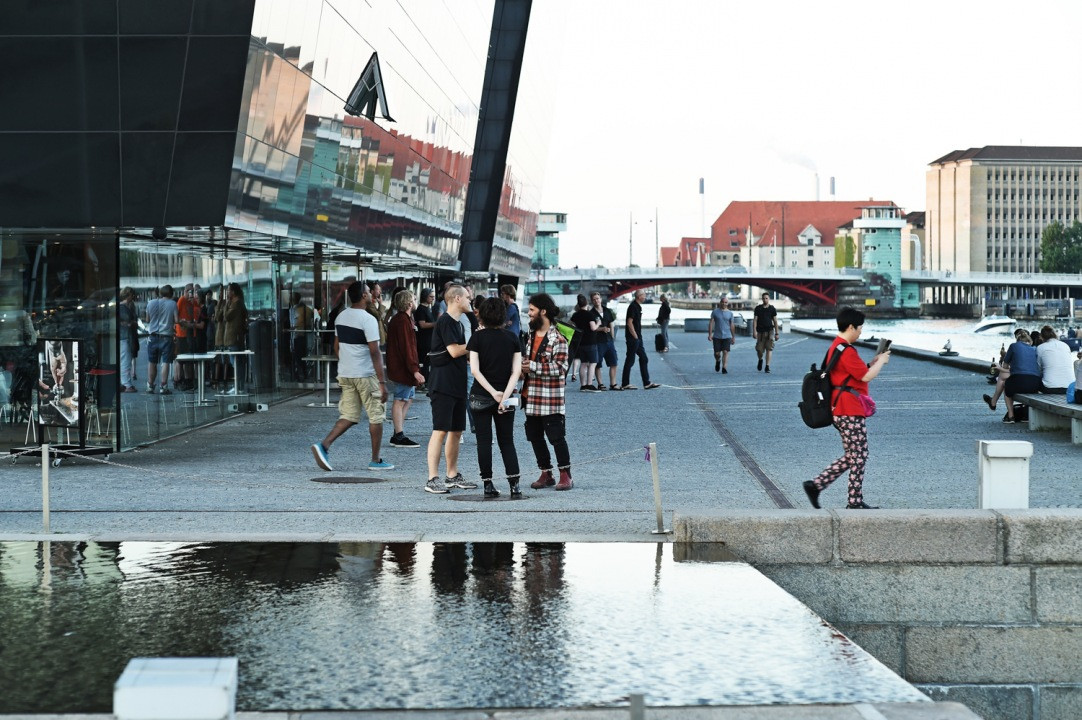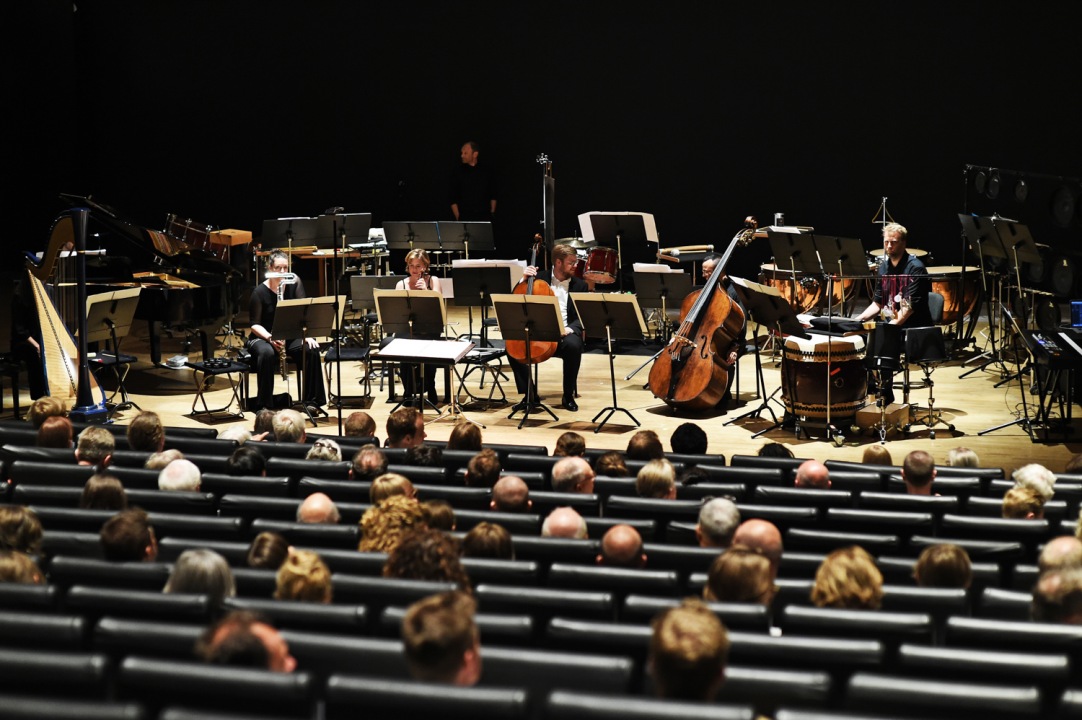
Lullabies and memory loss
Then we enter this wooden box. I am utterly surprised by the sensation of enclosure this concert hall provides. I enjoy it though; this is a safe and secure cradle. Precisely a year ago, I remember now, another concert of Klang Festival took place in another concert hall here in Copenhagen – in the middle of roller coasters and carrousels, ghost trains and haunted houses. Once again, it is the end of May, a warm if not hot day. Sweat and an incredible bright sun shaped this day. Hence, I can also sense the comfortable and cooling enclosure in this wooden box, the Queen’s Hall in the Black Diamond – yet, at the same time the sun is still simmering on my skin, my head; my ears are still tired from the night before, from talking and responding, from drinking and travelling, though all very joyful.
But, yes: I am tired on this very evening – and still I look forward to these four individual concert performances tonight by the Athelas Sinfonietta. It is an experiment I wish to undertake here: Can I truly linger lovingly inside this sequence of performances, exploring their sensorial and fictional spaces of introductions and transitions, openings and closures, moving into various extremes of this perceptual sonario – happily deleting familiar names and historical precedence – just to extrude the experiential logic, the alternate dynamics of these four pieces?
My ears are still tired from the night before, from talking and responding, from drinking and travelling, though all very joyful
A detox?
The evening starts with a deceleration and an anti-climax. A hissing as if from tiny percussive insects, a swirling downward sound, repeatedly and repeatedly swirling downwards and evermore downwards. Instead of presenting some impressive and resonating big bang for a start on this evening, the first piece by composer Sarah Nemtsov – Luftmacumba/Rio (2011) – sets a fragile and a whirring tone. My listening body, my sensory corpus is, quite obviously, somewhat lost at this very moment. Remembering the theatrical and impressive composer performances of last year, at the Tivoli Concert Hall, this feels now like a withdrawal, maybe even a revocation of the theatrical as such – or just a kind of detox? Listening to this piece feels less corporeally present, less physically engaging. I am wondering if the effects of this piece, the sounds and agogics, the progress of this piece through time and all its repercussions from the concert environment – if all these effects will be capable of engaging me as much as a sensory corpus as last year’s performances did?
 Athelas Sinfonietta in the Queen’s Hall. © Alexander Banck-Petersen
Athelas Sinfonietta in the Queen’s Hall. © Alexander Banck-Petersen
Then, at precisely this point, I stopped working on this essay; for almost a week I did not write a word, maybe stunned by my observation of having felt less corporeally present, deeply disappointed and clueless, maybe just stupefied by my own rather egocentric expectations. I was travelling, grading papers and deeply immersed in reading literature for a book on sonic fiction I am also writing these days. But then, after giving a talk in Uppsala, where I introduced the audience to the main concepts of an anthropology of sounds, I was apparently able again to finally continue writing this essay. I got in touch again with the specific character of the corporeal experience provided by this very concert.
The sensory corpus I embodied at that evening in the Queen’s Hall was an overly sensible, idiosyncratic, a highly irritable soft machine (Burroughs). I was tired, thus. But I was curious, still. I observed my fellow listeners in this wooden box, all the expert listeners, composers, critics, fellow musicologists and sound artists, also positioned quite neatly in the auditory dispositive of this specific concert hall. I wondered how they were following this series of performances with their senses and their current somatic states, their highly individual sensory corpuses? Would they find it easy to incorporate them in their sonic personae, would they struggle? Would they lightheartedly and rather versatile let their thoughts, references and associations regarding these sounds and musical structures coalesce into words and sentences, into arguments founded on observations, including a final aesthetic verdict? Had they some templates at hand for their individual reviews or book chapters or musical analysis they intended to produce afterwards?
Then, at precisely this point, I stopped working on this essay; for almost a week I did not write a word, maybe stunned by my observation of having felt less corporeally present, deeply disappointed and clueless, maybe just stupefied by my own rather egocentric expectations
My body is listening
Right now, in the Queen’s Hall, my listening body wondered how exactly it got dragged through a theatre of sounds by the percussive flight of Sarah Nemtsov’s piece: consisting of surprising noises, clicking events and even a large sheet of plastic, tenderly and meticulously waved by instrumentalists – like an ocean for a puppet theatre. I felt dragged across and all along the complete tonal spectrum as the various instruments at times emulated wind chimes or a glockenspiel. Did I even detect some trace elements of microtonality in this performance – or was this just my wish to connect this sonic experience to a more familiar concept of musical aesthetics? Towards the end of this piece I wondered if some of the strangely quirky sounds produced by the instrumentalists actually bore more resemblance to a parody of Neue Musik? Or were they just very convincingly produced and inserted into the sequence of sound events, so that after a beginning doubt I simply forgot about them? Joyfully, some sequences continuously entered the realm of lullabies, and again I wondered; I enjoyed them.
This consistent ground of doubt and wondering about the tender and ambiguous quality of these sounds and their sequences, their at times comic background and sinister embedding, all of this continued even more after the transition to the following piece by Ricardo S. Eizirik: Moloch Machine, 1927 (in Two Parts) (2016/17). The doubt about a forced comic performance when bringing a bicycle on stage; later the use of a melodica, the shovelling sounds of percussion, the tender hissing and blowing, the sounds of falling projectiles, many tiny bullets, all across the spectrum again. The bicycle percussion established largely a machine-like deceleration sequence, completed with its subsequent acceleration and speeding up afterwards. A cinematic development of sounds and dynamics emerged from these mechanical and cyclical clicking sounds, grey and toneless. A silent calm was expressed – and a use of instrumental mechanics that reminded me, for some seconds at least, of Lachenmann’s activation of the most marginal sounds of the philharmonic apparatus; but then I realized the dynamics of tension, lowered and heightened, a kind of time-lapse and the use of castanets. Beauty emerges. And apparently, the playful instrumentalists, they liked to perform all of this.
 A bicycle used for Ricardo S. Eizirik’s ‘Moloch Machine, 1927’. © Alexander Banck-Petersen
A bicycle used for Ricardo S. Eizirik’s ‘Moloch Machine, 1927’. © Alexander Banck-Petersen
What happened?
The third piece before the break – and at this point I had to stop again with writing this essay; for a few days only, though. Several weeks after this concert evening I seem now to have a really hard time to remember what happened then and what I experienced there. The four performances now seem even more remote than before; but maybe also more intense in the selected excerpts and experiences I still actually remember? More stylized also? I return to my notes. In them I read that the third piece was the world premiere of Morten Ladehoff’s Automateria. Following my further notes, I read some words and phrases – but I am not so sure what I meant with them when I wrote them down at the concert. What did I actually intend to make out of this in the end? What can I make out of this now? My memory fails. Were these four performances not impressive enough? Was I too tired that evening? Did I continuously fall asleep – maybe without realizing this and only panickingly waking up at a later point in the piece? Momentary interjections of memory loss?
If I remember Ladehoff’s piece now, I can also hear again Morton Feldman’s Coptic Light (1986), its tender, but squeakingly annoying slightly upward and downward pitch: a seducingly sedative rocking of sounds, a rotating of pitches that never fails to put me asleep – a creaking and squeaking, seducingly tender as a lullaby. A lullaby for memory loss. – Then I woke up again, sweatingly shocked, from the next tutti passage. Phew. My listening body truly failed that night. I got consumed, I got devoured by this musical piece. Only in the following break, having a cold drink, listening to the educated small talk of some colleagues and friends, I realized that. Failed and lost, a lullaby. A lullaby that is eating up its audience, paralyzed and solidified all listeners?
My listening body truly failed that night. I got consumed, I got devoured by this musical piece. Only in the following break, having a cold drink, listening to the educated small talk of some colleagues and friends, I realized that
Returned to my seat I listened to, I indulged in, the sounds of Bernhard Lang’s Monadologie XI ‘for Anton’ – 2. Kammersinfonie (2010). Again I heard and recognized the downward squeaking sounds, the grey sounds and flurry sounds; I registered the structural formations of this piece, the slow and deep sounds. They roll beneath me. And again I drifted into a sonario, a sonic scenario of soft and caressing airflow sounds. Strange plastic tubes, whirly tubes, were used as instruments, they rotated above the heads of instrumentalists. Tiny percussive sounds, simmering air sounds. Do I hear insects here? Or again and again the ever-present downward movement of sounds? Is this just another lullaby? Just another memory loss?
After the concert, strolling over the Knippelsbro, I slowly, doubtfully, went directly home; but I cannot remember anymore how I actually got home. Was I sleepwalking? Did the memory loss extend beyond the evening of the concert? Was I engaged as the protagonist of a lullaby? I wondered: Was my sonic persona now completely dissolved into the airflow, the rotating squeaking and the percussive sounds of this night?

